#smithfield decretals
Explore tagged Tumblr posts
Text
A glorious woman acrobat balancing on sword tips as musicians play. From the Smithfield Decretals, c. 1340.

"Normal Women: 900 Years of Making History" - Philippa Gregory
#book quotes#normal women#philippa gregory#nonfiction#acrobatics#acrobat#swords#musician#smithfield decretals#40s#1340s#14th century
3 notes
·
View notes
Text
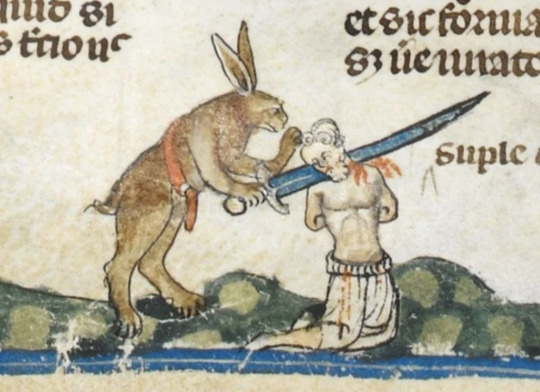
Killer rabbits in medieval manuscripts: “Smithfield Decretals”, c. 1300, British Library, London, UK. Detail.
(That’s where the killer rabbits in Monty Python come from!)
1 note
·
View note
Text

check out this Yoda-looking dude from the 14th century Smithfield Decretals
Do y’all think siblings in medieval times would look at the little beasts in illuminated manuscripts and point at each other like ‘ha! ‘Tis thou!’
226K notes
·
View notes
Text

~ "Messenger approaching a King and Queen, Smithfield Decretals, France, XIV'th century." ~
1 note
·
View note
Photo







The Three Living and the Three Dead 1. Bas-de-page scene of the Three Living, from the Smithfield Decretals, southern France (probably Toulouse), c. 1300, with illuminations added in England (London), c. 1340, Royal MS 10 E IV, fol. 258v, 2. Susanna Greer Fein, "Life and Death, Reader and Page: Mirrors of Mortality in English Manuscripts", Mosaic: An Interdisciplinary Critical Journal, March 2002, Vol. 35, No. 1, a special issue: HAUNTING II: Citations 3. Bas-de-page scene of the Three Dead from the Smithfield Decretals, southern France (probably Toulouse), c. 1300, with illuminations added in England (London), c. 1340, Royal MS 10 E IV, fol. 259r, 4. Susanna Greer Fein, "Life and Death, Reader and Page" 5. Detail of bas-de-page miniature of the Three Living from the Taymouth Hours, England, 2nd quarter of the 14th century, Yates Thompson MS 13, fol 179v. 6. Susanna Greer Fein, "Life and Death, Reader and Page" 7.Detail of bas-de-page miniature of the Three Dead, from the Taymouth Hours, England, 2nd quarter of the 14th century, Yates Thompson MS 13, fol. 180r
#three living and three dead#medieval literature#medieval manuscripts#memento mori#parallel texts#my stuff
20 notes
·
View notes
Photo
source?. sauce plz?. i want to know. rabbits. bunnies. this looks to be just the one manuscript.
They’re not quite all from the same manuscript, though they are all from the same webpage that did a post at Easter a couple of years ago.
They’re usually marginalia drolleries, of course.
All but three of these eight are from the Smithfield Decretals, aka The Decretals of Gregory IX, at the British Museum, which also includes this one:

The exceptions are: The third one is from Ms 107, Bréviaire de Renaud de Bar (1302-1304), fol.-89r-141v, Bibliothèque de Verdun, as is the seventh
The 4th one is from ms. 0121, f. 023 at the Bibliotheque de la Sorbonne in Paris.
And here’s a link to the Smithfield Decretals, which has way more fun stuff with rabbits, bears, lions, and whatnot.
https://www.bl.uk/catalogues/illuminatedmanuscripts/record.asp?MSID=6549

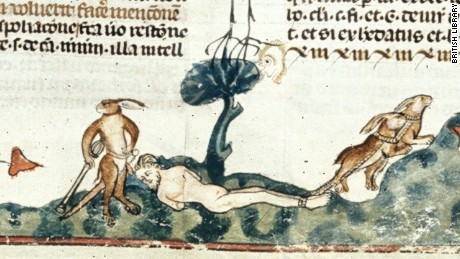
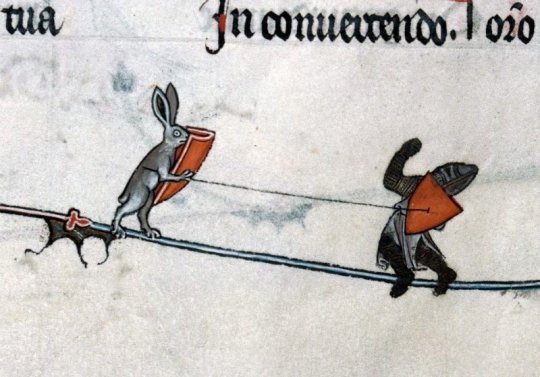
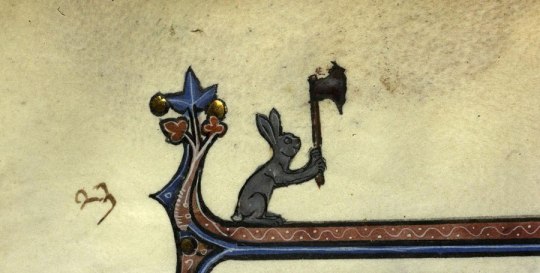
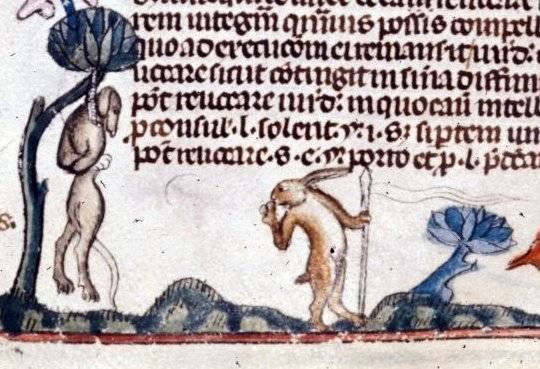
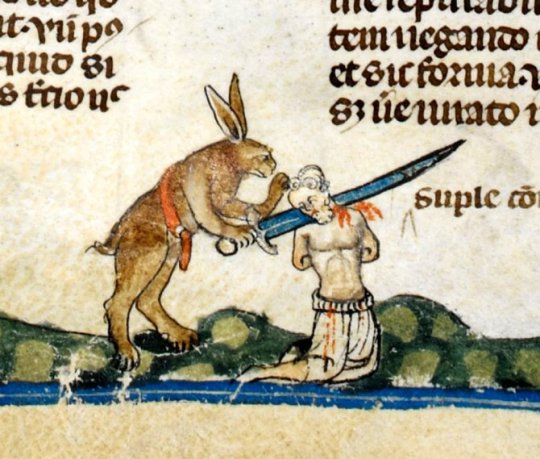


Medieval Killer Rabbits.
#art#history#rabbits#medieval#manuscripts#marginalia#drolleries#d.c.a.#society for creative anachronism#smithfield decretals
4K notes
·
View notes
Photo


Absolutely Not Yoda™ ‘The Smithfield Decretals’ (Decretals of Gregory IX with glossa ordinaria), Toulouse ca. 1300, illuminations added in London ca. 1340 British Library, Royal 10 E IV, fol. 30v @discardingimages
64 notes
·
View notes
Photo

Image of a Monk attempting to bludgeon Satan and his minions, from the Smithfield Decretals
When I could not be rid of the devil with sentences out of Holy Scripture, I made him often fly with jeering words [...] He is a proud spirit, and cannot endure scorn.
- Martin Luther (Table Talk, Anecdote 606)
Some folk have been clearly rid of such pestilent fancies with very full contempt of them, making a cross upon their hearts and bidding the devil avaunt. And sometimes they laugh him to scorn too, and then turn their mind unto some other matter. And when the devil hath seen that they have set so little by him, after certain essays, made in such times as he thought most fitting, he hath given that temptation quite over. And this he doth not only because the proud spirit cannot endure to be mocked, but also lest, with much tempting the man to the sin to which he could not in conclusion bring him, he should much increase his merit.
- Saint Thomas More (Dialogue of Comfort Against Tribulation, 2.16.725-734)
8 notes
·
View notes
Text

An english naval battle with two cogs , in: Smithfield Decretals, Ms. Roy. 10 E IV, fol. 19, early 14th century. London, British Library
38 notes
·
View notes
Text
When the Nordics were summoned to Earth, they needed a method to combat the dark alchemy of the indigenous people of Earth.The Nordics were introduced to a race of Pygmies that dwelled in inner Earth. The pygmies innerstood a great amount of secrets pertaining to Earth's resources & the weaknesses of indigenous people that lived on Earth's surface. In exchange for this knowledge of indigenous people's weaknesses, the Nordics promised the Pygmies material riches after the Nordics increased their population & took control of the Earth. Over time, the Nordics crossed genetics with the Pygmies, giving birth to a species known as "Elves" or "Gremlins." Most of these Elves/Gremlins were gatekeepers & oracles for the Nordics in power.They showed the Nordics how to manipulate light to combat the forces of Dark Magic.This is one of the main reasons we Washitaw were conquered for the last 500 years.The character "Yoda" in StarWars is a depiction of an Oracle Gremlin that helped the Roman Catholic church defeat the Washitaw Empire.The Catholic Church & Gremlins used Light Magic to defeat us. Not Dark magic.There is a French manuscript from the 1400s named the "Smithfield Decretals." In the manuscript, you clearly see a short, green being, with a hunch back & elf ears, strikingly similar to Yoda. Ive stated in many lectures before the Jedi are a depiction of the beings that served the Catholic Church & the Demiurge.The Sith are a depiction of the Washitaw Muur Empire. When you turn Yoda's head upside down, he has the ears of Baphomet, which makes perfect sense because, the Gremlins & Catholic Church serve the demiurge, & so does the baphomet. When you hear me call myself "Dark Yoda" I'm saying that I'M the oracle that's using Dark Magic to help the indigenous rise to power again & regain a knowledge of self. Me calling myself "Dark Yoda" is me using the warlock's magic against them.

2 notes
·
View notes
Photo

Congratulations on them weird shaped tiddies.
Smithfield Decretals (Decretals of Gregory IX) c.1340
13 notes
·
View notes
Photo

Happy Leap Day!
Detail of the 14th century Smithfield Decretals describing how to add the leap day to the calendar—but as Feb. 24(b) instead of Feb. 29!
Partial translation:
A standard solar year has 365 days and six hours, so in four years’ time these hours make 24 extra hours, which must be added as a new day to every fourth year. This additional day is what we call “double-sixth-day”, because, although it is counted as an addition, it stands under the same number as the previous day in the calendar, so that the two days are regarded as one and the same. The extra day is inserted in the calendar after 24 February (six days before the first day of March) so that we celebrate the memory of St Matthias the Apostle (24 February) on the next day, too.
The practice dates back to the Romans, and Leap Day is still called “double-sixth-day” in French (dissextile), Italian (bisestile), and Greek (disektos).
[source - British Library]
16 notes
·
View notes
Photo

Royal MS 10 E IV. Date c 1300-c 1340. Title Decretals of Gregory IX with gloss of Bernard of Parma (the 'Smithfield Decretals'). Detail Folio 153r.
1 note
·
View note
Photo
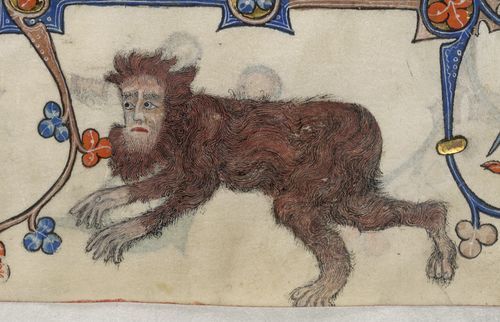

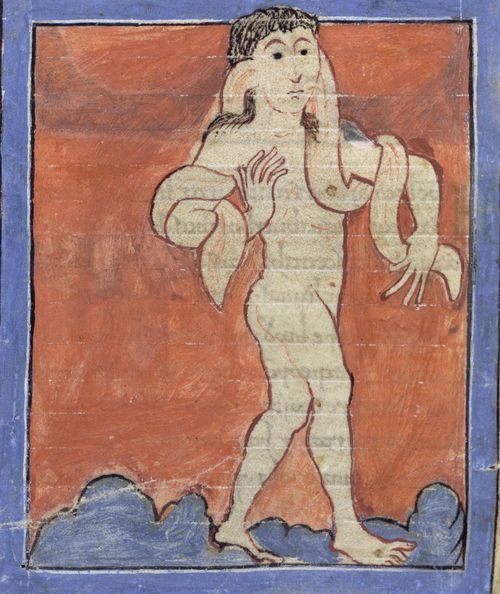

Happy Star Wars Day! May the Fourth Be With You!
In celebration of this most solemn holiday the British Library Blog has created a post with selected illustrations from some of their manuscripts in tribute to the Star Wars universe. A few of them are above, many more at the BL Blog.
1K notes
·
View notes
Text
Okay, so @assoc-of-free-people completely ignores the point made by @fantasysclerois re: emulating mosaic style on vellum or parchment (not paper!) is super difficult to start, and you often only get the one chance, but also that the images shown are from a) wildly different time periods, b) wildly different manuscript contexts, and c) wildly different manuscript typologies.
The first image is from the Pierpont Morgan Library MS M.736, folio, 9v, an historical text, and depicts an invasion of vikings in England. For the size of the MS, and the amount of detail involved in it is fantastic for the scale. Not to mention that the faces in it are a pretty good representation of the mosaic portraits.
The second image is marginalia from the Smithfield Decretals, Royal MS 10 E IV, a 14th century copy of a 13th century legal educational book. The marginalia is there to fill the page, to help keep the reader from nodding off, and to perpetuate the meme of knights fighting snails.
The final image is from a Book of Hours, a religious devotional text containing prayers, hymns, and psalms. This particular one is from Clermont-Ferrand, Bibliothèque municipale, ms. 84, fol. 27r, and depicts a lion, which has connotations nobility, royalty, etc. Which is exactly what you'd want when you're a Christian drawing stuff relating to Christ.
As far as the comment on medieval sculpture not being as good as Roman...holy fuck I don't have time to explain how wrong you are about this, but please, I'm begging you, pick up a book. Read Medieval Sculpture by Roberto Salvini. It's a good primer. It will show you dozens of beautiful medieval sculptures, from effigies to pietas, to decorative works.
And now on to you, @untitledtitled.
I am no fan of Christianity. I am not a particularly religious man, either. But I am an historian, and holy o-fuck I don't know where the hell you got this idea from (just kidding, you're a fan of The Chart, aren't you? It's absolute bullshit btw) but you could not be more wrong. The Carolingian Rennaissance, around the 8th century, saw massive overhauls in education, art, culture, and architecture. Carlingian miniscule, one of the most readable manuscript hands, comes from this period. Schools and literacy were springing up everywhere. That was *because* of the centralizing power of Christianity.
The Ottonian Rennaissance in the 10th century is where arts and architecture really take off, with renewed contact between Western Europe and Constantinople helping bring huge amounts of expertise into the area. This is when illuminated manuscripts really start coming into their own.
Then there's the 12th Century Rennaissance. Which is where Universities start cropping up. And philosophy and science start roaring back, what with the increased availability of Hellenic and Islamic texts. The Islamic Golden Age was right at its height at this time, and the exchange between Western Europe and the Islamic world meant huge amounts of increase in scientific, medical, and philosophical knowledge.
Western Europe saw a massive destabilization with the collapse of the Roman Empire in the 5th century. Depopulation, collapse of infrastructure, destruction of social structures, you name it. But institutional Christianity managed to maintain some semblance of order, and allowed for the development of art, literature, philosophy, science, and technology. So don't bring your edgelord atheist dudebro bullshit into this historical arena, unless you've got something more substantial than The Chart to back it up.
i think people in the middle ages acutally did know how to make photorealistic drawings they just chose not to because it’s funnier to draw some fucked up creature
158K notes
·
View notes
Text

Violent killer rabbits in medieval illuminated manuscripts. (From the Smithfield Decretals, the Gorleston Psalter, and the Breviary for the Use of Verdun, all 14th century CE)
0 notes